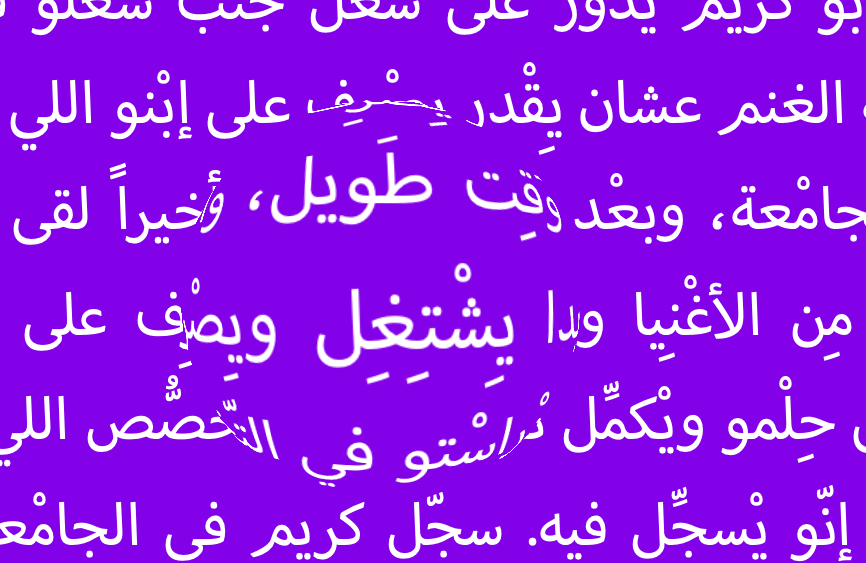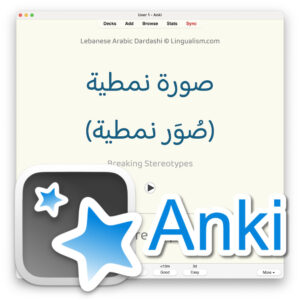Table of Contents
Introduction
Levantine Arabic has no official spelling rules–no standardized orthography. Still, native speakers do write in their dialects, perhaps increasingly in recent years with the advent of the internet and text messaging. So, how can we write in the Levantine Arabic dialect if there’s no right or wrong–no rules to follow?
Well, Arabs seem to make it work. Most Levantine Arabic words have cognates in MSA, so these spellings are applied to Levantine Arabic whenever possible. For example, there’s no debate on how to spell the word for ‘book’. It’s كتاب, just like in MSA. But when it comes to Levantine Arabic words that are unique or significantly differ from MSA, there is less uniformity. Even then, there are usually only a couple of competing spellings. Individuals have their own preferences or use both interchangeably. هلّق or هلّأ (now). هِنِّ or هِنّي (they).
The Lingualism Orthographic System
In Lingualism materials, we do our best to keep spelling consistent and in line with whichever spelling variant seems to be the most widely used.
Arabic script doesn’t always represent the exact pronunciation of Levantine Arabic. When words take prefixes and suffixes, certain sound changes occur. Vowels are lengthened, shortened, or elided according to certain rules. The quality of vowels changes depending on adjacent consonants. Consonants can also become voiced or devoiced in certain positions. None of this is explicitly reflected in the Arabic script, but with the help of diacritics and knowledge of the rules of Levantine Arabic phonology, you can determine nearly any given word’s pronunciation from the Arabic script.
Notable Consonants
Most consonants in Levantine Arabic are pronounced as they are in Modern Standard Arabic (MSA)*. But how do native speakers spell words that have markedly different pronunciations from MSA? Basically, if a word has a cognate in MSA, the spelling will mirror that word.
However, there are a couple of exceptions and notable cases. Let’s take a look:
ث
Many varieties of Levantine Arabic do not have the ŧ ([θ] as in English thin) sound of MSA. This sound usually becomes s in Levantine Arabic cognates, and sometimes t. When pronounced s, the original spelling with ث is kept. (It is not spelled with س.) But when it is pronounced t, it is written ت.
sêbit ثابِت (stable)–from MSA ثابِت
tāni تاني another–from MSA ثانٍ
ذ
The same applies to ذ, which is pronounced đ ([ð] as in English that) in MSA but can be pronounced z or d in Levantine Arabic. The spelling is retained when it is pronounced z. (It is not written as ز.) But it is written د when pronounced d.
záki ذكي clever–from MSA ذكي
áxad أخد he took–from MSA أخذ
ق
In Levantine Arabic, qaaf (ق) is most commonly pronounced as a glottal stop, as if it were hamza (ʔ ء), in the majority of words, but it is still written as ق. In some everyday words (as well as in more formal words borrowed from MSA), ق is pronounced q. In some varieties of Levantine Arabic (notably, Palestinian Arabic), ق can be pronounced as a hard g (as in English gas).
ج
Instead of MSA’s j ([dʒ] as in English jam), in Levantine Arabic, ج is pronounced [ʒ] like a French j or as in the English words pleasure or vision.
Taa Marbuuta
When taa marbuuta (ة) is pronounced t as the first part of an idaafa construction, a sukuun is added: ـةْ:
ɧadēʔit ɧayawênêt حديْقِةْ حَيَوانات zoo (lit. garden of animals)
Other spelling conventions
Shadda
Shadda is used instead of writing double consonants, following the rule in MSA.
ba3átti بعتّي you sent (and not بعتْتي).
ʔúlli قِلّى (not قِلْلى) tell me
Exception: ílli اللى (that, which, who) is written with two lam (ل), as the first two letters were originally the definite article. (A variation of this word is written يَلّي.)
Diacritics
Tanwiin
Tanwiin sits on a final alif (In MSA, it should ‘correctly’ precede the following consonant, although many people disagree and write it on the final alif. We’ve mimicked this popular convention: dáyman دايْماً always
Default omissions
Fatha: By far the most common vowel in Arabic is the short vowel a, which is represented in Arabic script by fatha ( ـَ ). In Lingualism materials, the fatha is normally omitted. So if you see a consonant without tashkeel, you can assume it is an unwritten fatha. This is done to avoid redundancy and making the text look cluttered. Fatha is, however, written adjacent to waw (و) and yaa (ي) when they are pronounced as consonants (w and y, respectively) in order to distinguish them from long vowels:
wálad وَلد boy
yá3ni يَعْنى that is…
ɧawāla حَوالى about, around
ɧayāti حَياتى my life
In the rare cases where a word-final short a is not represented by ا or ـى, the fatha is written:
3a عَ on
húwwa هُوَّ he
Sukuun: Levantine Arabic does not have i3raab (grammatical declensions). Compare Levantine ktêb كْتاب (book) with MSA kitābun كِتابٌ. This implies that the final consonant would be written with a sukuun (كْتابْ), but, again, this is omitted to avoid redundancy. You can assume that a final consonant has an unwritten sukuun.
Long vowels are not preceded by harakat (short vowel marks):
nêm نام he slept–not نَام
mīn مين who–not مِين
rūɧ روح go–not رُوح
The definite article الـ is written without tashkeel (instead of اِلْـ ). This is done to avoid clutter: ilbēt البيْت the house (not اِلْبيْت ); iššámis الشّمِس the sun (not اِلشّمِس ).
This also applies to ílli اللى that, which, who.
Glides
ي and و can represent various sounds. As the long vowels ī and ū, they are not preceded by harakat. (See above.)
These letters can also represent two long vowel sounds not present in MSA: ē and ō. These are written with sukuun to distinguish them from the cardinal long vowels:
dēn ديْن debt (vs. dīn دين religion)
fōʔ فوْق above (vs. fūʔ فوق surpass)
When these letters represent true diphthongs, fatha is also written (ـَوْ and ـَيْ) to distinguish them from the above cases:
yáwmi يَوْمى daily
ɧaykūn حَيْكون he will be
In summary:
wa وَ
ya يَـ
aw ـَوْ
ay ـَيْ
ō ـوْ
ē ـيْ
ī ـي
ū ـو
Shadda
Shadda is written as in MSA, even at the end of a word where we don’t actually hear the consonant pronounced twice. Why? It is perceived to be a double consonant and the shadda helps in word recognition. If, for example, a suffix is added, you would hear the consonant pronounced twice. Also, two consonants at the end of a syllable affect word stress.
biɧíbb بيحِبّ (he loves). Without the double consonant, the stress would incorrectly fall on the first syllable (bíɧib بِحِب).








Wow this is excellent. It’s consistent and flawless. I hope that eventually a complete series of Levantine Arabic Grammar is presented. For Egyptian Grammar J.Woidich Kullu Tamam is (almost) perfect. Of course, I’d prefer, if that book used a similar ortho system as you presented here. I wonder, if there is any book on Levantine Grammar that is so complete as J.Woidich’s book on EA?
Excellent guide, but, and please forgive me, there is one thing missing. The long vowel alif ا is sometimes pronounced as ā and other times as ê. I can’t seem to figure out a rule for this. Can you comment on this?
This guide is focused on orthography–how we spell words and use tashkeel in our materials specifically. I’ll do another guide on pronunciation and our system of phonemic transcription at some point (hopefully soon!).
But to answer your question briefly, there is no hard and fast rule. It has a lot to do with the adjacent consonants (dark consonants cause alif to be pronounced ā (as in father) in most cases, and often with r, as well), but there are exceptions. It also depends a lot on regional variations. A word pronounced with ē (as in wait) in Lebanon might be ā in Syria. In the Shwayy ‘An Haali books, we use the symbol ê to mean ē in Lebanese and ā in Syrian pronunciation. So, the best advice, in my opinion, is just to mimic native speakers as you hear them on the accompanying audio.